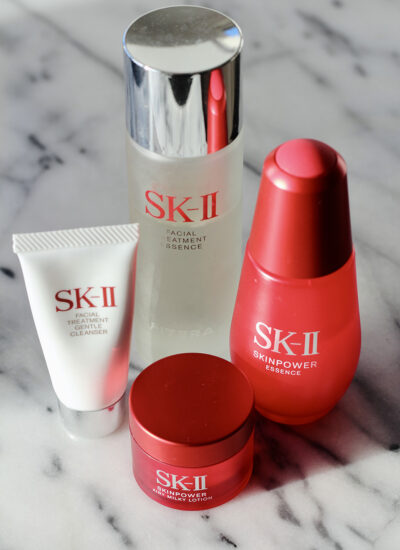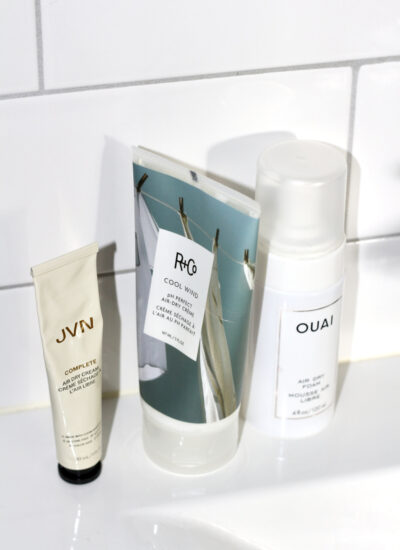
As someone who loves trying new skincare products, I often find myself falling into the rabbit hole of over-treating my skin. At least once a year, I accidentally push the boundaries on what my skin is able to handle. I reckon I’m not the only one doing this mistake? Whether it’s trying to follow the brand’s recommended use, other people’s formula, having a 10-step routine, or simply getting the wrong product for your skin type.
Here’s my simple trick on what I do to get my skin back on track.

What causes the skin to become distressed?
There is a multitude of causes for a broken skin barrier. But the most common when it comes to skincare is the overuse of retinol and chemical exfoliants. Then we have been using the wrong product, over-exfoliating with a mechanic brush, using too many products with active ingredients, and not wearing sunscreen when using actives.
Overall, my issues, have mostly stemmed from trying to push the use of actives (retinol and acids) too frequently within a week for too long.
How do you recognize over-treated skin?
The symptoms of a damaged skin barrier range from increased rough and flakey texture to redness. Dryness, oiliness, increased acne and sensitivity is all signs of compromised skin.
One thing I’ve noticed (with my own skin) to be a huge sign that I’m overdoing things, is that whatever actives or products I’m using, starts to make my skin worse and work against its purpose. Counting on that this product used to work in the past and I’ve been diligent with wearing sunscreen.
Another great example in my case has been when using chemical exfoliants and retinol too frequently. My skin texture becomes bumpy, I get more blackheads, and my skin doesn’t feel as soft and smooth anymore. Despite pouring it with skin smoothing products. Not to mention that it becomes easily surface dry too.
That’s a key warning that my skin barrier is damaged and that it hasn’t gotten enough time between actives to fully recover and repair!
The irony in all of this is that when your skin texture starts to look worse, you instinctively want to turn to products like retinoids and acids to smooth it out and treat it. You might even believe that if you stop using those products your skin will get even worse!
The thing is, if your skin barrier is fine, the exfoliants will help and give you instant gratification. But if the rough skin texture is caused by the exfoliant, it’s like trying to put out a fire with gas. Putting down the gas and relying more on hydration is what’s going to help you get back to a smooth complexion. Simply, don’t do anything.
Sounds contradictory, and it’s a hard pill to swallow for most of us skincare junkies… But if you don’t step away from the actives, your skin will keep being troublesome and your addiction even harder to break.

How To Repair Your Skin Barrier
Some call it a skincare detox or skincare fast, but that sounds like you’re giving up all skincare. While that might also work, I don’t believe anyone needs to be that radical about it. What your skin needs in a compromised state is a break with lots of TLC. Basically, you scale back to having a basic skincare routine.
What You Will Need
Three things are all you need to help get your skin back to normal: Cleanser, Moisturizer and a sunscreen.
However, I do like to add two additional treats just because sometimes swapping is easier on addiction than cutting out.
Opting for fragrance-free products is preferred, but mildly fragrance is fine as long as you know your skin is okay with that.
Base
- A Gentle Low pH Cleanser
Options: CeraVe Moisturizing or Foaming Cleanser, LRP Hydrating Cleanser.
– When it comes to choosing a cleanser, go for one that has a simple and hydrating formula with not a lot of active ingredients.
If you wear makeup, always double cleanse! Either with micellar water or a balm/oil cleanser that’s easily rinsed off.
- A Basic Moisturizer
Options: CeraVe moistruzier, La Roche Posay Toleriane, The Ordinary NMF.
– Look for something preferably with ceramides, carbamide, niacinamide, and natural moisturizing factors (NMF). But most importantly, try looking for something simple that doesn’t use a dozen different extracts and so forth. A moisturizer should simply moisturize, reduce water loss and help strengthen the skin barrier.
- Sunscreen of SPF30 or more.
Options: La Roche Posay Anthelios, Cerave sunscreen.
– Protecting your skin from the sun is crucial in letting your skin have all the time it needs to heal. Skin that doesn’t need to defend itself from harsh rays often heal quicker. Go with one that you enjoy applying.
Optional
- Hydrating Barrier Repairing Serum or Toner
Options: Alpha H Vitamin B, The Ordinary HA+B5 or Amino Acid+B5, NIOD Modulating Glucosides, Lumene Oleo Serum, Paula’s Choice Calm Serum.
– There’s a sea of hydrating serums and toners out there. Try to look for ingredients with hyaluronic acid, niacinamide, panthenol, natural moisturizing factors, propolis, and ceramides.
Toners with a more emulsion/lotion type of texture with ingredients mentioned above can be used instead of or in addition to a serum.
- Face Oil Options: Squalane, The Ordinary B Oil, ByBi CBD Oil.
– Depending on what type of hydrating serum you go with and your skin type, you might not need additional oil. The reason for using it is to lock in hydration. When your skin barrier isn’t working properly moisture escapes more easily. Adding oil on top of your moisturizer or mixing it in, will help preserve the moisture for longer.

How long will it take to rehabilitate?
Skin renews itself about every 28-50 days. You should start to see slight improvements within two weeks. But you truly should give it at least four weeks before gradually incorporating strong actives back into the routine. Especially the ones that caused the burnout in the first place. If you do decide to introduce milder actives (like AHA at <5% and BHA at <1%) around the 2 week-mark, know that you may be prolonging the process. Be careful, as it’s easy for the skin to swing back to worse again.
To avoid future issues, you should reconsider and modify the frequency of use of products with strong active ingredients to give your skin time to recover and repair. Maybe opt for lower strengths? And if you’re anything like me, who has (or had) an arsenal of different products on rotate, you may also want to pick one or two to truly stick to. Instead of confusing your skin and causing a burnout.
Your skin does not need to be exfoliated every day, day and night. Following the old school recommendations of one to three times/week is actually not so dumb. Today you’ll see many brands pushing consumers to use strong products daily, which is not ideal for most skin types. Just like when building muscle, it’s a good practice to incorporate “rest days/weeks” in your skincare routine.
Spacing out the days between retinol and acids or opting for milder alternatives is good practice to avoid damaging your skin long term and actually maintain happy and beautiful skin. ✨







